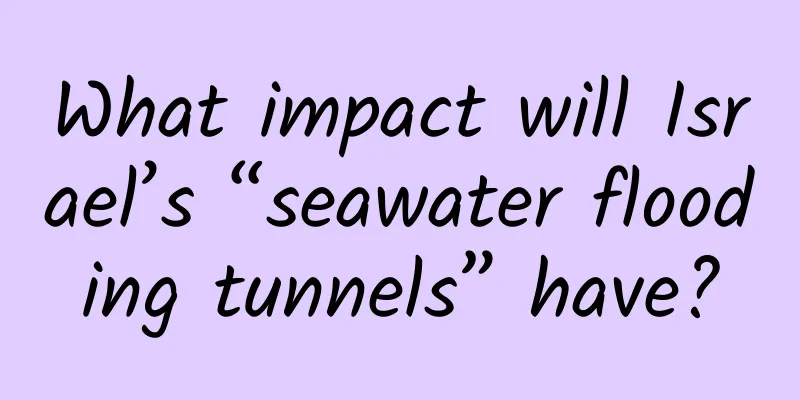What impact will Israel’s “seawater flooding tunnels” have?

|
On December 4, the US media revealed that in order to fight against the underground tunnel system of the Hamas organization in the Gaza Strip, Israel was preparing to use large pumps to extract seawater and flood the underground tunnels. On the 12th, CNN reported that Israeli officials informed the United States that they had begun "cautious testing" to "flood some tunnels in Gaza with seawater on a limited basis." During this process, some media reported that video images of some Hamas militants surrendering and disarming were circulated on social media. There were also reports that it might be related to the "seawater flooding tunnels" operation. At present, Israel has not announced the specific details of the "seawater flooding tunnel" plan, but this approach has still attracted widespread attention from the international community. So why does this approach cause controversy, and what problems will it bring? What consequences will “seawater flooding the tunnel” bring? Regarding the plan of "flooding the tunnels with seawater", the focus of the debate is mainly on two aspects: on the one hand, no one can be sure whether "flooding with seawater" can really completely destroy the tunnels, and this method may endanger the lives of hostages in the tunnels. On the other hand, directly pouring a large amount of seawater into the ground may cause a series of clear secondary disasters, endangering the ecological environment, destroying urban buildings, and endangering the lives and property of innocent civilians. This is why Israel's plan has caused such a lot of controversy. So is it really effective to pour a large amount of seawater into the tunnels? What kind of impact will it bring? Let's talk about it in detail. What is the effect of flooding the tunnel with sea water? Previously, the main way the Israeli military dealt with these underground tunnels was blasting. But the underground tunnels in the Gaza Strip are too complicated. The currently known length of the tunnel is about 480 kilometers. The effect of blasting them in sections in the current way is limited, and fighting may occur during the blasting process, causing casualties among Israeli soldiers. Therefore, the Israeli military came up with the tactic of pumping seawater to flood the underground tunnels. Theoretically, pouring a large amount of seawater into the tunnel is indeed a feasible way to drive out the people hiding in the tunnel. In addition, the tunnels in Gaza were not designed and constructed according to the flooding scenario. There are a lot of gaps in the concrete walls of the tunnels. Once seawater seeps in from the gaps, it may cause the tunnel to collapse. Seawater will also corrode the concrete walls of the tunnels, making them more fragile and vulnerable. There are a lot of gaps in the concrete walls of the tunnel. Image source: Wikipedia The situation inside the tunnel. Image source: Wikipedia Although it seems feasible, according to a source from The Times of Israel, Israel does not know the details of the tunnel, how the injected seawater will eventually flow, or the permeability of the soil around the tunnel. In other words, Israel is still unsure whether the seawater can completely flood the tunnel and whether it can cause the tunnel to collapse. Moreover, there are currently 137 hostages in the tunnel, including 17 women and children. Blindly taking this action may threaten the lives of the hostages in the tunnel. The effects are unknown and could have disastrous consequences Israel’s “flooding plan” is still in progress and its final effect is still unknown, but pumping large amounts of seawater into the ground may cause a series of potential risks. 1 Threat to urban building safety At present, Israel is unable to determine where the injected seawater will eventually flow to, and how much seawater will penetrate into the soil. If a large amount of seawater penetrates into the foundations of buildings around the tunnel and stays there for a long time, it may corrode the foundations, and in serious cases, it may cause the collapse of the house. One of the important reasons why seawater can accelerate the corrosion of reinforced concrete is that it contains a large amount of chloride ions. Chloride ions can penetrate into ordinary concrete several centimeters deep in just half a year, destroying the passivation film on the surface of the steel bars inside, leaving them in a corrosive environment. At the same time, chloride ions themselves can also accelerate the electrochemical corrosion process of steel bars. In addition, sulfates in seawater will directly react with silicate cement to form tiny crystals of calcium sulfonate and gypsum. The formation of these crystals will increase the volume, causing the cement to expand, resulting in cracking and peeling of the structure, and reduced strength. Considering that the foundations of most buildings on land have not been specially treated with "anti-seawater corrosion", the foundations of nearby buildings will become more fragile under the action of seawater erosion, and may even cause building collapse accidents. In June 2021, an apartment building collapsed in Florida, USA, resulting in 98 deaths and 11 injuries. One of the important reasons for the collapse of the building was the corrosion of the foundation and pillars by salt water infiltration. For buildings that need to be built in seawater environments, people will use special anti-sulfate cement and perform special treatment on the concrete, such as applying anti-corrosion paint. The concrete surface of the Hangzhou Bay Bridge in my country is coated with a variety of anti-corrosion coatings to slow down the corrosion of concrete by seawater. Anti-corrosion coating on the concrete surface of Hangzhou Bay Bridge. Image source: Reference 5 In addition, when constructing projects in seawater environments, there are more stringent standards from the selection of steel bars and concrete, coatings, design to maintenance to ensure building safety. Corrosion prevention measures for reinforced concrete in marine environments. Image source: Reference 5 The houses in the Gaza Strip are obviously not built according to the anti-corrosion standards of the "marine environment". If a large amount of seawater suddenly seeps in, it may cause safety accidents such as ordinary houses tilting and collapsing after a period of time, causing casualties and property losses. 2 Soil salinization Soil salinization is the accumulation of soluble salts (such as sodium chloride) on the surface of the soil. It may be caused by natural factors such as climate and hydrology, or by human factors. No one has yet tried to study whether pouring seawater into tunnels will lead to soil salinization, but according to Wim Zwijnenburg, head of the Netherlands Humanitarian Disarmament Project, Israel needs to extract at least 1 million tons of Mediterranean seawater to flood all the tunnels. These seawaters are likely to penetrate into the surrounding soil, and after the water evaporates, a large amount of salt will remain in the soil. Regardless of whether Zwijnenburg's speculation is accurate, a large amount of salt will be left in the soil of the Gaza Strip. In Gaza, only about one-third of the land is "irrigation water source land" that can be used for farming. If these lands are salinized again, the already scarce arable land in the Gaza Strip will become even scarcer. Moreover, once the soil is salinized, it is difficult to repair. It takes a long time and a lot of manpower and material resources to make the salinized arable land suitable for farming again. In my country, in order to deal with the salinization of cultivated land, two main strategies have been adopted: one is to vigorously select salt-tolerant crops so that they can grow smoothly on slightly salinized cultivated land; the other is to use a large amount of fresh water to directly wash away the excess salt in the soil. Flushing the soil requires a large amount of fresh water resources. In my country, fresh water resources are relatively abundant, and we can still use fresh water from rivers near saline-alkali land to improve the land. But in the Gaza Strip, where fresh water resources are in short supply, such a treatment method seems too luxurious. 3 Increased groundwater salinity According to a report released by the United Nations Environment Programme in 2009, for many years, the extraction rate of groundwater resources in the Gaza Strip has been much faster than the replenishment rate, and groundwater resources are already scarce. Excessive groundwater extraction in coastal areas can also cause low groundwater pressure, leading to seawater intrusion. In some coastal cities in my country, such as Shenzhen, groundwater extraction is prohibited to prevent seawater intrusion. Image source: Shenzhen Municipal People's Government official website Seawater intrusion has caused the salt content of groundwater in most parts of Gaza to exceed the safety standards set by the World Health Organization. Even so, it is reported that before the outbreak of the Gaza conflict in 2023, 59% of the daily water used by residents in the Gaza Strip still comes from groundwater. At present, affected by the war, each person in Gaza can only get an average of 1 to 3 liters of fresh water per day, far below the standard of 15 liters per person per day. If Israel decides to extract seawater to flood the tunnels, a large amount of seawater will seep into the ground, which may make the already extremely scarce and highly salty groundwater completely unusable. Perhaps Israel's "seawater flooding tunnels" plan can achieve some "results" in the short term. But its final result is still unknown. The possible side effects of this plan will obviously make the innocent civilians living in the Gaza Strip worse, and even cause a humanitarian disaster over a longer time span. References [1]http://www.news.cn/mil/2023-12/06/c_1212311029.htm [2]https://www.reuters.com/world/middle-east/israel-considers-flooding-gaza-tunnels-with-seawater-wsj-2023-12-05/ [3]https://news.un.org/zh/story/2009/09/118932 [4]https://sputniknews.cn/20231102/1054634033.html [5] Tian Huiwen, Li Weihua, Zong Chengzhong, Hou Baorong, et al. Research progress on corrosion mechanism of reinforced concrete and anti-corrosion coatings in marine environment [J]. Coatings Industry, 2008, 38(008): 62-67. [6]https://sputniknewsbr.com.br/20231205/israel-avalia-plano-para-inundar-tuneis-de-gaza-com-agua-do-mar-diz-midia-31848127.html [7]https://m.huanqiu.com/article/4FhOHdVmTYz Planning and production This article is a work of Science Popularization China-Starry Sky Project Produced by: Science Popularization Department of China Association for Science and Technology Producer|China Science and Technology Press Co., Ltd., Beijing Zhongke Xinghe Culture Media Co., Ltd. Author: Tian Dawei, Master of Environmental Science, Institute of Oceanology, Chinese Academy of Sciences Reviewer: Li Anjie, Associate Professor, School of Environment, Beijing Normal University Zhu Xuanxuan, Senior Engineer, Architecture Department, Beijing Municipal Engineering Design and Research Institute Co., Ltd. |
<<: Avoid lightning! This is the seat where you feel the most turbulence in an airplane
>>: Check it out! It's not a "kitchen magic weapon" but a "time bomb"
Recommend
Summary of content community product operation methodology
Content operation refers to the complete operatio...
How would you set up an account for multi-region advertising?
Account structure is both our tool to control tra...
If Darwin were alive today, he would rethink "The Origin of Species"
Anyone who has seen the movie "Prometheus&qu...
This article teaches you how to build a self-media matrix and acquire customers at low cost!
Someone asked me: Without money or resources, can...
How to activate the massive Qianchuan delivery on Douyin?
On April 9, Douyin's Juliang Qianchuan was of...
How does Baijiahao self-media make money? How can a novice quickly become a regular employee and earn income?
In recent years, self-media has been booming, and...
A different "cow" experience: Enjoy the TV version of "People's Niu Niu"
Screen: operate: Sound Effects: Plot: Experience:...
React Native Introduction and Getting Started
1. Introduction [[169817]] ReactNative.png React ...
The driving force behind polar cold waves: How does the jet stream shape the Earth’s climate and weather?
Tuchong Creative The westerly jet stream is a pow...
Can diabetic patients control their blood sugar better if they don't eat staple foods? Here comes the November scientific rumor list →
1. Will eating hawthorn and chestnuts together ma...
Wang Xuehong is obsessed with VR: HTC CEO may fall into industry misunderstanding
At the recently concluded MWC2016, VR once again ...
Infographic: How much do programmers earn in 2014? Should you change jobs?
I remember when I graduated and looked at the job...
Will an unstoppable cough lead to pneumonia? Huaxi doctors: Beware of these obvious symptoms!
"Cough, cough ... Coughing is really annoyin...
How to implement community operation SOP?
The article shared today is a concise SOP from at...
From C-end to B-end, my product design journey
I remember when I was interviewing for Lenovo'...









